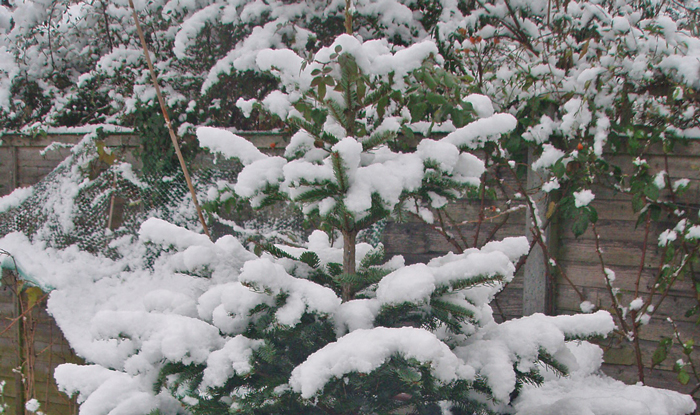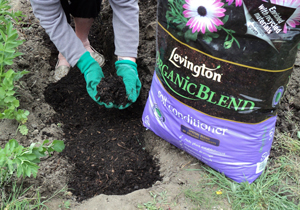December Garden Diary
Welcome to the December edition of our Garden Diary, written for us by Geoff Hodge, of The ScottsMiracle-Gro Company. Keep up-to-date with what needs doing in your garden with our month by month column.
There seems to be much debate from the weather experts on what conditions we can expect through December. These range from average temperatures and rainfall, through extensive bands of rain, sleet and snow through to severe cold! Which just goes to show – there’s nothing more unpredictable than the UK weather.
All we can say is – stay alert and, like any good Scout, be prepared and keep an eye on your garden and plants! Remember not to neglect our bird friends during the cold weather.
FLOWER BEDS & BORDERS
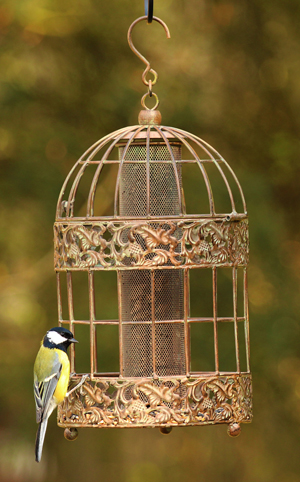 Herbaceous perennials are difficult to beat for the colour and interest they provide. Providing the soil isn’t frozen solid or waterlogged, this is a brilliant time to plant them. To get the best results, dig over the soil where they’re going to be planted, remove any perennial weeds, dig in plenty of organic matter, such as Levington Organic Blend Soil Conditioner, and add some Miracle-Gro Bonemeal to the soil/organic matter mix. Plant firmly and water in well afterwards.
Herbaceous perennials are difficult to beat for the colour and interest they provide. Providing the soil isn’t frozen solid or waterlogged, this is a brilliant time to plant them. To get the best results, dig over the soil where they’re going to be planted, remove any perennial weeds, dig in plenty of organic matter, such as Levington Organic Blend Soil Conditioner, and add some Miracle-Gro Bonemeal to the soil/organic matter mix. Plant firmly and water in well afterwards.
A 5-7.5cm (2-3in) thick mulch of Miracle-Gro Moisture Control Decorative Pine Bark or Levington Water Saving Decorative Bark will ensure they get off to the best possible start, help keep weeds down and retain soil moisture in spring and summer.
You can propagate several herbaceous perennials from root cuttings taken now. These include Acanthus, Anemone hybrida, Campanula, Echinops, Eryngium, Papaver orientale, Phlox, Primula denticulate and Verbascum. Root cuttings can be easier to care for than some stem cuttings and they are less likely to dry out or rot.
Lift the plant and wash the roots or gently dig around the plant and tease out strong, healthy roots. The root cuttings can be rooted in the ground or a cold frame, but rooting is better in a heated propagator at around 18-24C (65-75F). Cut off a healthy root and cut into 5cm (2in) (if rooting in the ground or cold frame) or 2.5cm (1in) (if rooting in a propagator) sections; make a straight cut at the top of the sections (taken from nearest the plant) and angled cut at bottom to help you tell top from bottom. Space them out in pots filled with a 50:50 mix of a Miracle-Gro multipurpose compost and Levington John Innes Seed Compost or Levington John Innes No1 Compost and press down into the compost. Then cover the compost surface with grit or gritty sharp sand.
Topical tip
Deadhead winter-flowering pansies to keep them flowering during mild weather. Tidy up plants and remove any yellowing leaves to prevent any disease build up.
PATIO GARDENING
Keep a careful eye on container plants and don’t be fooled by any periods of wet weather. Although it may be raining, the compost may not receive enough moisture and need watering throughout winter. This is particularly true of plants in small pots, pot-bound plants, hanging baskets and containers under overhanging structures.
Topical tip
If you haven’t already, raise containers on to bricks or purpose-made pot feet to avoid them sitting in water, otherwise the compost can become waterlogged, leading to root rotting, and making terracotta pots more prone to cracking.
LAWNS
Avoid walking on the lawn during frosty weather. It can damage the grass and lead to brown, footprint-shaped areas if you don’t. Similarly, keep off the grass if it is extremely wet or waterlogged. This is particularly the case on heavy clay soils, as this will lead to soil compaction, which will make the problem worse.
However, the grass will continue to grow at temperatures above 5C (41F), so it may be necessary to use the mower to keep the lawn in trim. Ensure the cut is 6mm (1/4in) higher than during the summer to prevent turf stress. This usually means a cutting height of around 5cm (2in) for most lawns.
And if you can get onto the grass, re-cut lawn edges to crispen up the appearance of the garden, and repair damaged lawn edges.
Topical tip
If you’re not using your mower, have it serviced now. If you leave it until spring, you may have to wait weeks to have the work completed.
GROW YOUR OWN
Now is a good time to dig over vacant areas of vegetable plots on clay soil, as the cold weather will help to improve the soil structure by breaking down large clumps into crumbly particles. Light, sandy soils are best left until spring, but you can help improve soil structure by putting a thick layer of organic matter over the soil now. Thoroughly dig over any bare areas of soil, incorporate plenty of well-rotted organic matter, such as Levington Organic Blend Soil Conditioner and, at the same time, remove any weeds. Winter digging not only helps improve soil structure, it also exposes soil pests to frost and bird predators.
Once the soil has been dug over and any large clumps broken down, you can cover it with thick black polythene, weed control membrane or similar coverings. This will keep the soil in good condition until spring, when it will be easier to prepare for planting and sowing and keep weeds down.
Clear away crops as they go over and put them on the compost heap or, if they are suffering from severe disease, dispose of them. Check overwintering crops and remove any yellowing or damaged leaves. Crop and other plant debris left lying around will become a home and breeding place for pests and diseases.
Topical tip
If you’re growing crops in the greenhouse, make sure you water carefully, and don’t overwater them. Excess water sitting around plants at this time of year can lead to botrytis disease.
Fruit
It’s time to get the secateurs busy, as there are plenty of pruning jobs to get on with during winter. If necessary, you can winter prune established, free-standing apple and pear trees; the main pruning of cordons and espaliers should be left until summer. Don’t prune cherries, plums and peaches, as pruning of all stone fruit must be carried out in late spring or summer.
Make sure you have a plan of attack and don’t just prune for the sake of it. You should be thinking about removing the following:
• The four Ds – any growth that is dead, dying, damaged or diseased (such as infected by canker).
• Growth that is crossing from one side of the tree to the other, as this can reduce airflow and increase disease problems.
• Any branches that are rubbing, as this can cause damage.
• Any branches that are growing too low and any that are growing too tall.
Currants and gooseberries can be pruned now. Start by thinning out very old, very thin and diseased growth.
Prune red and white currants and gooseberries by cutting back main branches by half to three-quarters and sideshoots on these branches to one to three buds from their base. For blackcurrants, cut back up to one-third to a half of all the older branches to their base to give plenty of room for young, vigorous growth. Grape vines can be pruned now; major pruning at other times can lead to severe bleeding, which will weaken the vine and may even kill it. This year’s sideshoots should be hard pruned to one or two buds.
Topical tip
Carefully rubbing off the old, loose bark of grape vines can help prevent problems with overwintering pests.
TREES, SHRUBS, ROSES & CLIMBERS
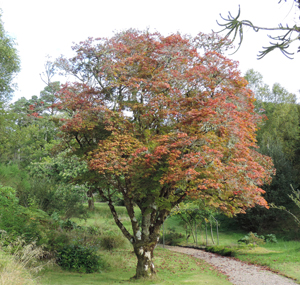 December is a great time for moving young deciduous small trees, shrubs and climbers that are growing in the wrong place or have outgrown their allotted space. Old plants may not establish well and so may not be worth taking the risk – but if you have to do it, then you have to.
December is a great time for moving young deciduous small trees, shrubs and climbers that are growing in the wrong place or have outgrown their allotted space. Old plants may not establish well and so may not be worth taking the risk – but if you have to do it, then you have to.
Where possible, start by pruning back up to half of the top growth – moving puts a stress on the plants and you can reduce this stress by reducing the amount of stems and leaves the plant has.
Water the soil around the plant thoroughly the day before. Dig up as big a rootball as possible/you or you and a friend can manage. Replant in well-prepared soil with plenty of added Levington Rose, Tree & Shrub Compost and Miracle-Gro Bone Meal Root Builder, so that the rootball sits at the same level as it was originally, covered with no more than an 2.5cm (1in) or so of soil. Tall shrubs and trees may need staking to keep the roots secure.
Water in well after moving – and for the first year to ensure the plants establish properly. Mulch the soil around the plants with Miracle-Gro Moisture Control Decorative Pine Bark or Levington Water Saving Decorative Bark.
Hard pruning and renovation of many overgrown deciduous trees, shrubs and hedges can be carried out from now throughout the winter; it’s easier to see what you’re doing when the plants have dropped their leaves.
The exceptions are tender plants, and also Prunus species (such as ornamental cherries), as these are vulnerable to diseases if pruned now. Evergreens are also usually best left until the spring. When doing any pruning, take the opportunity to examine branches for signs of disease. Small cankers and dieback are best removed early before they spread further.
Topical tip
If there is any snow, you should carefully brush this off the branches of conifers and other evergreens. Heavy snowfall can damage or splay the branches and spoil the overall shape of the plant.
GENERAL GARDENING JOBS
Now is an excellent time to treat fences with a wood preservative. Deciduous climbers will have lost their foliage and can easily be moved out of the way. If possible, don’t be tempted to cut them back, unless you know that pruning now won’t affect flowering next year. Cover nearby plants with a polythene sheet or similar to prevent damage from splashing with the preservative.
Although garden birds rely on us more and more to put out food for them all year round, they are more in need during cold and especially freezing weather. During winter, they need food with a high fat content to survive the cold weather. The ChapelWood range contains a wide range of wild bird food suitable for feeding at this time of year.
Top up bird feeders as necessary. Bird tables should only be stocked with enough food that the birds can eat without leaving excess from day to day. And don’t forget to ensure there is a supply of unfrozen, clean water.
If your garden pond contains fish, then it’s vital to keep an area of its surface free from freezing over, otherwise the fish can suffocate. You can either float a small ball on the surface, melt it daily using a pan of hot water held on the ice or invest in a good pond heater, such as the Bermuda Pond Heater or Bermuda Extra Power Pond Heater.
Topical tip
Make good use of quiet moments to clean all your old pots and seed trays, so that they’re ready for seed sowing in spring.
HOUSEPLANTS
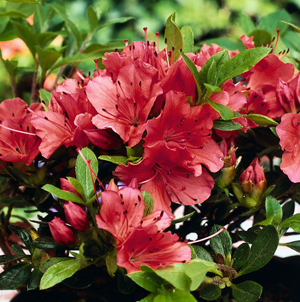 We buy a lot of houseplants for Christmas, and also receive them as Christmas presents, so it makes sense to know how to look after them to ensure a long-lasting display. Cyclamen and azaleas appreciate a cool room (10-13C/50-55F) with good, diffuse light, whereas poinsettias need a warm (15-21C/60-70F), light place, away from drafts.
We buy a lot of houseplants for Christmas, and also receive them as Christmas presents, so it makes sense to know how to look after them to ensure a long-lasting display. Cyclamen and azaleas appreciate a cool room (10-13C/50-55F) with good, diffuse light, whereas poinsettias need a warm (15-21C/60-70F), light place, away from drafts.
Water cyclamen from below by filling the saucer with water until the plant takes up no more – then throw away any surplus; watering in the top of the pot may rot the tuber. If you have hard, chalky tap water, water azaleas with rainwater or deionised water. Keep poinsettias moist, but don’t overwater them.
Always use tepid water at room temperature – never use water straight from the cold tap.
Indoor amaryllis (Hippeastrum) are popular winter houseplants. Pot up the bulbs using a good compost, such as Miracle-Gro Potting Mix Root Boosting Compost, in pots only a couple of inches wider than the width of the bulb, with only the bottom third of the bulb planted; leave the remaining two-thirds above the compost level. There’s no need to regularly water and feed until the bulbs come into growth.
To find out more about caring for these and other Christmas houseplants, visit www.lovethegarden.com/gardening-growing/caring-christmas-houseplants
Topical tip
Flowering houseplants will give a better display for longer if fed weekly with a liquid houseplant fertiliser, such as Miracle-Gro Pour & Feed.
Use plant protection products & biocides safely. Always read the label and product information before use.
Products marked ® and ™, Miracle-Gro®, Levington®, ChapelWood® and Bermuda® are trademarks of The Scotts Company LLC or its subsidiaries.

